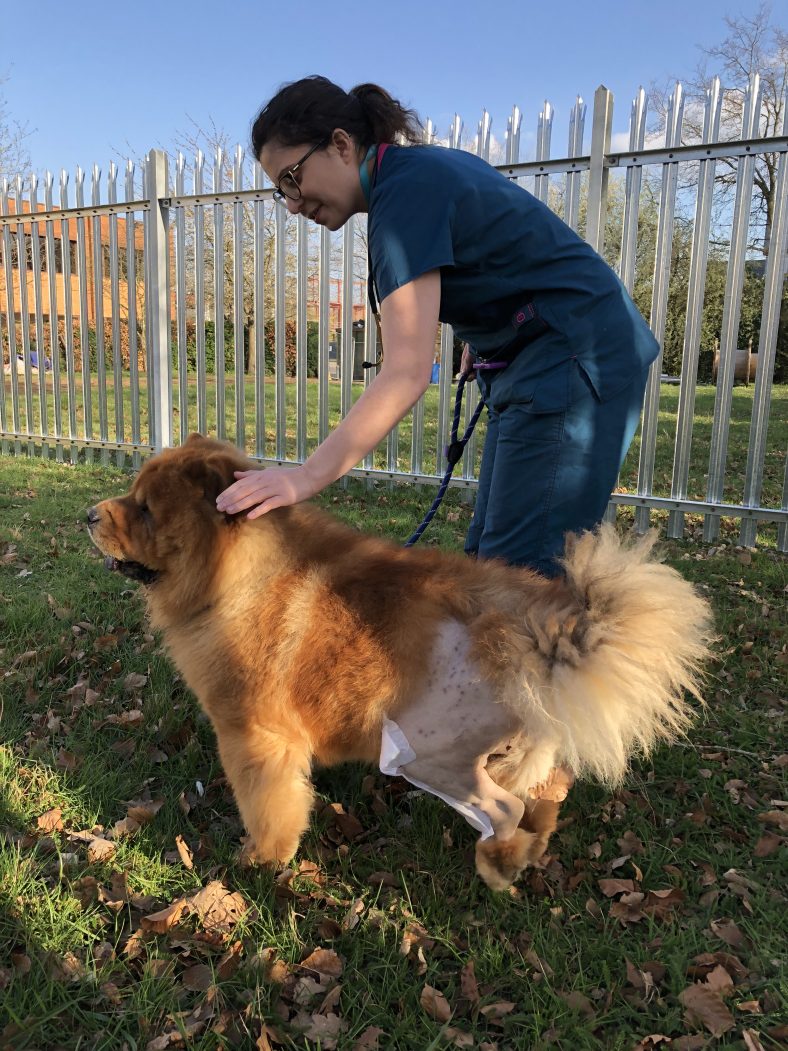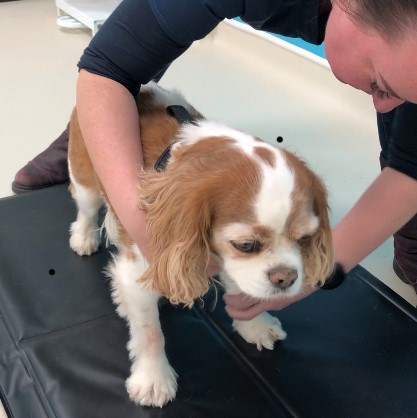Our Community
TPLO (knee) surgery for dogs – what’s it all about?
Like us humans, dogs can suffer from joint problems. You may hear of sportsmen and women tearing their ‘ACL’ (anterior cruciate ligament) putting them out of action for a while. Sadly, the same can happen to our beloved dogs (and cats). We asked our Orthopaedic Surgeon, Stefano, and our Head of Physiotherapy and Rehabilitation, Kim, to tell us more about the condition and how you treat it.
If your pet is about to undergo TPLO surgery check out our TPLO animation to learn more about the surgery, and what you can expect post-surgery.
Let’s start with some of the background, Stefano, what are the cruciate ligaments?
The cruciate ligaments are structures located within the stifle (knee) joint that contribute to joint stability and avoid abnormal joint movements. They join the femur (thigh bone) and the tibia (shin bone) together inside the joint. There are two cruciate ligaments in the knee: a cranial ligament and a caudal ligament. Lesions affecting the caudal ligament are extremely rare in dogs and the vast majority of “cruciate disease” affects the cranial ligament. The cranial cruciate ligament is the same as the anterior cruciate ligament in a human (ACL) which many people, especially sportspeople, frequently injure.
And so what causes the cruciate ligament to tear?
Unlike humans, dogs tend to suffer from a cranial cruciate ligament rupture (tear) due to the progressive weakening of the ligament which is caused by a predisposition, for example, obesity. This means normal daily exercise can result in the partial or total rupture of the ligament causing lameness in the leg and potentially severe discomfort – you may see your dog lifting their leg up when they try to walk or run.
What are the treatment options when this happens?
For some dogs, conservative management may be appropriate involving rest, time, pain management and physiotherapy. However, in many cases, surgery is required. There are several surgical procedures available to stabilise the joint. TPLO is currently thought to be the best option for both stability and post-operative recovery.
The surgical procedures performed in dogs differ from those carried out in humans because the ligament isn’t replaced in dogs as it is in humans. In the human knee, the bones are stacked on top of each other in standing with no bend whereas a dog always has a natural bend in their knee. In dogs, the joint becomes unstable because the relative angle of the bones to one another puts too much stress on the cranial cruciate ligament leading to its rupture. If you can correct the relative angle of the bones to one another in a dog’s knee, you can make the joint stable without having to replace the ligament.
Replacing the cranial cruciate ligament has been attempted in dogs. However, it was found that the replacement ligament also ruptures too frequently to make it a sensible treatment option. In humans, the ligament usually ruptures due to excessive force and replacement is the preferred option.
Can you tell me more about a TPLO – what does it mean?
TPLO is the acronym of “tibial plateau levelling osteotomy”. The surgery is based on cutting the proximal part of the tibia (the shin bone next to the knee joint) along a curved line and then rotating the joint surface down to a lower angle. This eliminates the abnormal movements that would be present when the cranial cruciate ligament is ruptured.
And so why is TPLO commonly used in cruciate ligament disease?
Slocum TPLO is regarded as the gold-standard procedure as it represents a permanent, reliable way of restoring excellent joint function in dogs affected by a cranial cruciate ligament rupture. This procedure offers the highest success rate when compared to other alternative surgeries. It is well-standardised and carries minimal risks (although, as for every orthopaedic surgery, some risk of complications is present).
So we know that surgery can correct the tearing of the cranial crucial ligament, but how do you restore movement back to what it was? Our Head of Physiotherapy + Rehabilitation, Kim, tells us more…

This is Oscar and our nurse Olivia out in the garden post-surgery. Oscar underwent a TPLO and is now receiving physiotherapy to restore his leg function.
Kim, is there anything you can do to prepare for surgery?
The short answer – yes! Even when your dog is on restricted rest before their operation, it is useful to perform carefully tailored strengthening exercises at home. This helps to keep their leg muscles from wasting too much (as they are not used as much as normal). These exercises form part of ‘prehabilitation’ and have a number of benefits (this applies to dogs who are unable to have surgery as well):
- The stronger the muscles supporting the joint are, the more stable and less painful the joint is likely to be.
- The rest needed before the surgery (to prevent pain from getting worse) leads to the patient becoming deconditioned (less fit, causing loss of muscle). Prehabilitation helps to alleviate this and retain muscle strength.
- The stronger the joint (and patient) is before the surgery, the easier post-operative recovery should be.
- A recognised problem with a cranial cruciate ligament tear is that the other leg becomes more vulnerable to tearing as well. This is likely because the other leg is bearing more weight to compensate for the injury. By strengthening both back legs, less stress is put on the unaffected leg, which may help to stop it from becoming problematic. If both knee joints need operating on, the prehabilitation exercises help both limbs too.
And what about after surgery – how can physiotherapy benefit the recovery of a patient?
Physiotherapy from the first-day post-surgery is normal in the rehabilitation of humans who have their anterior cruciate ligament repaired. For the same reasons, this is beneficial for dogs too.
Immediately after surgery, it is vital to reduce the swelling and encourage the patient to use the operated leg. This:
- Helps to prevent muscle wastage
- Increases proprioception (joint awareness) of the knee joint
- Provides better stimulation of the bone to heal
- Reduces the likelihood of loss of range of motion (which is a common problem after a cranial cruciate ligament tear)
As the swelling reduces, and the leg starts to heal, the exercises should be progressed appropriately to help the patient get back to their full function. This can be tricky in dogs as they can hide weakness in one leg much more easily than a human can because of the other three legs. Many dogs who do not have physiotherapy after surgery may look normal when they conduct their daily activities but the operated leg will remain weaker than the others. This puts more stress and weight on the unoperated side of the body and may contribute to why a cranial cruciate ligament tear on the ‘stronger’ side of the body frequently occurs around 6-12 months after surgery.
Controlling the rate that the patient returns to normal is also very important. Some dogs are very comfortable really soon after surgery and will want to be more active than they should be to allow the best recovery possible. Other dogs will be slower to progress back to their usual functionality. Regular checks with your physiotherapist can help to give more individual guidance about how much your dog should or shouldn’t be doing. This is especially true here at The Ralph where we have a Stance Analyser that measures the percentage of weight your dog puts through each leg. This allows us to easily see if they are still favouring a particular leg even when it doesn’t look like they are to the human eye!

Here is Kim with Ruby on the Stance Analyser.
Our Home Exercise Programmes are developed for each patient and given to carers upon your dog’s return home. The programme includes exercises to help strength the leg, improve movement and utilise your dog’s energy. This helps to avoid any accidents or over-excitement when your dog goes out into the garden or to the toilet.
Rehabilitation with guidance from a physiotherapist supports your dog to make a strong and full recovery and to restore their full function. Be it running around the agility course, working or a healthy walk along the beach.
To find out more about our Orthopaedic Surgery Service and Physiotherapy + Rehabilitation Service please click on the links.
Is your pet about to undergo TPLO surgery? Check out our TPLO animation to learn more about the surgery, and what you can expect post-surgery.
Take care,
The Ralph Team
